Hydroponic green walls offer a sustainable and space-efficient solution for urban environments by growing plants without soil, using nutrient-rich water instead. These living walls improve indoor air quality, reduce noise pollution, and enhance aesthetic appeal while requiring less maintenance compared to traditional soil-based gardens. Integrating hydroponic green walls into buildings supports biodiversity and contributes to energy savings through natural insulation.
Introduction to Hydroponic Green Walls in Living Wall Gardens
Hydroponic green walls in living wall gardens utilize soilless systems to grow plants vertically, optimizing space and resource efficiency. These walls employ nutrient-rich water solutions circulated through substrates to support plant growth, enhancing air quality and interior aesthetics. Innovative designs integrate sustainable technology to maintain plant health, making hydroponic green walls an eco-friendly solution in urban landscaping and indoor environments.
Key Benefits of Hydroponic Living Walls
Hydroponic living walls maximize space efficiency by growing plants vertically without soil, enabling cleaner indoor air through enhanced oxygen production and pollutant absorption. These systems reduce water consumption by up to 90% compared to traditional soil gardening, promoting sustainable urban environments. Enhanced thermal insulation and noise reduction properties contribute to energy savings and improved indoor comfort.
Choosing the Right Plants for Hydroponic Green Walls
Selecting the ideal plants for hydroponic green walls involves prioritizing species adapted to nutrient-rich, soilless environments with consistent moisture. Popular choices include pothos, philodendrons, ferns, and various succulents, which thrive in hydroponic systems due to their resilience and low maintenance needs. Incorporating plants with complementary root structures and light requirements ensures balanced growth and optimal air purification in hydroponic living walls.
Essential Components of Hydroponic Wall Systems
Hydroponic green wall systems rely on key components such as a nutrient delivery system, growing medium, and structural support frame to ensure optimal plant growth and stability. The nutrient solution is circulated through pumps and tubing, providing water and essential minerals directly to plant roots without soil. Efficient lighting, sensors for moisture and pH levels, and a drainage system are also critical for maintaining plant health and preventing root rot in hydroponic living walls.
Step-by-Step Installation Guide for Hydroponic Green Walls
Installing a hydroponic green wall begins with selecting a suitable structure and securing it firmly to a supporting surface, ensuring optimal light exposure and accessibility for maintenance. Next, set up the hydroponic system by installing water pumps, tubing, and nutrient reservoirs, followed by placing appropriate planting panels or pockets filled with a soilless growing medium. Finally, integrate chosen plant species based on light and growth requirements, adjust water flow and nutrient delivery schedules, and monitor the system regularly to promote healthy, lush vertical vegetation growth.
Optimizing Lighting and Irrigation for Hydroponic Living Walls
Optimizing lighting and irrigation for hydroponic living walls involves selecting full-spectrum LED grow lights that mimic natural sunlight, ensuring consistent and energy-efficient illumination. Automated irrigation systems with precise nutrient delivery and moisture sensors maintain optimal hydration levels, preventing overwatering and promoting healthy plant growth. Integrating smart controls allows real-time adjustments to lighting intensity and water flow, enhancing plant development and reducing resource waste.
Ongoing Maintenance Tips for Hydroponic Green Walls
Regular monitoring of water pH levels and nutrient concentration is essential to maintain optimal growth in hydroponic green walls. Cleaning filtration systems and checking for algae buildup prevents blockages and ensures efficient water circulation. Consistent pruning of plants promotes healthy foliage and prevents overgrowth, supporting sustained plant vitality.
Common Challenges in Hydroponic Living Wall Gardens
Hydroponic living wall gardens often face challenges such as nutrient imbalances, water management issues, and root oxygenation problems that can hinder plant growth. Pest infestations and disease outbreaks are common due to the high humidity levels typical in hydroponic setups. Proper system monitoring and maintenance are essential to prevent these issues and ensure sustainable plant health.
Sustainable Practices in Hydroponic Green Wall Design
Hydroponic green wall design emphasizes sustainable practices by utilizing nutrient-rich water solutions that minimize soil use and reduce water consumption by up to 90% compared to traditional gardening. Integrating recycled materials and energy-efficient LED grow lights further enhances environmental responsibility. These systems promote urban biodiversity and improve air quality while supporting resource-efficient maintenance.
Inspiring Examples of Hydroponic Green Walls in Urban Gardens
Hydroponic green walls showcase innovative urban gardening by growing plants without soil, using nutrient-rich water solutions that maximize space and sustainability. Notable examples include the vertical gardens at CaixaForum Madrid, which utilize hydroponics to filter air and reduce urban heat, and the green facades of the Bosco Verticale in Milan, where diverse plant species thrive on hydroponic systems integrated into high-rise buildings. These inspiring installations demonstrate how hydroponic green walls contribute to air purification, biodiversity enhancement, and aesthetic transformation in densely populated cities.
Hydroponic green wall Infographic

 gardenot.com
gardenot.com